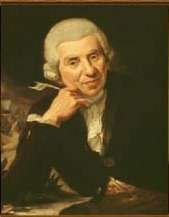Johann Wilhelm Ludwig Gleim

Johann Wilhelm Ludwig Gleim (2 April 1719 – 18 February 1803) was a German poet.
Life
Gleim was born at Ermsleben near Halberstadt. Having studied law at the University of Halle he became secretary to Prince William of Brandenburg-Schwedt at Berlin, where he made the acquaintance of Ewald von Kleist, whose devoted friend he became. When the prince died at the battle of Prague, Gleim became secretary to Prince Leopold of Dessau; but he soon gave up his position, not being able to bear the roughness of the "Old Dessauer".[1]
In 1747, after living in Berlin for a few years, he was appointed secretary of the cathedral chapter at Halberstadt. He became known as "Father Gleim" throughout all literary Germany on account of his kind-hearted though inconsiderate and undiscriminating patronage alike of the poets and poetasters of the period. He wrote a large number of imitations of Anacreon, Horace and the minnesingers, a didactic poem entitled Halladat oder das rote Buch (1774), and collections of fables and romances.[1]
Of higher merit are his Preussische Kriegslieder von einem Grenadier (1758). Inspired by the campaigns of Frederick II, they are often distinguished by genuine feeling and vigorous force of expression. They are also noteworthy as being the first of that long series of noble political songs in which later German literature is so rich. With the exception of this collection, Gleim's writings are for the most part commonplace in thought and expression. He died at Halberstadt on 18 February 1803.[1]
Gleim's Collected Works appeared in 7 volumes in the 1811–13; a reprint of the Lieder eines Grenadiers was published by A. Sauer in 1882. A good selection of Gleim's poetry will be found in Franz Muncker's Anakreontiker und preussisch-patriotische Lyriker (1894). See Wilhelm Körte, Gleims Leben aus seinen Briefen und Schriften (1811). His correspondence with Heinse was published in 2 volumes (1894/1896), with Uz (1889), in both cases edited by C. Schüddekopf.[1]
Many of his poems were set to music. The Kriegslieder proved very popular, and were set by Georg Philipp Telemann and Christian Friedrich Daniel Schubart. C.P.E. Bach, Beethoven, Haydn, Reichardt, Schubert, and Spohr all set some of his Anacreontic poems.[2]
Gleimhaus
After his death, his personal effects were carefully looked after by his great-nephew, Friedrich Wilhelm Körte (1776–1846). In 1862, Gleim's library of 12,000 books (including 50 incunabula) and the huge collection of letters, manuscripts and documents in his estate were used as the kernel of a museum of 18th century literary life in Halberstadt and beyond. It was augmented by the collection of Christian Friedrich Bernhard Augustin (1771–1856). Still in operation, the Gleimhaus is one of the oldest literary museums in Germany.
Temple of Friendship
At his house in Halberstadt Gleim created a "Temple of Friendship" (Freundschaftstempel): two rooms devoted to a collection of portraits of friends, which numbered more than 120 by the time of his death.[3] Artists commissioned by Gleim included Anton Graff, various members of the Tischbein family, Bernhard Rode[4] and Benjamin Calau.[5]
Gleim Prize
The Gleim Prize for Literature (Gleim-Literaturpreis), awarded for outstanding non-fiction on the subject of 18th century literature, was established in 1995.
- 1995 Heinz Dieter Kittsteiner
- 1997 Gudrun Gersmann
- 1999 Jürgen Osterhammel
- 2001 Martin Geck
- 2003 Christoph Schulte
- 2005 Angela Steidele
- 2007 Günter de Bruyn
- 2009 Mark-Georg Dehrmann
Notes
- 1 2 3 4 Encyclopædia Britannica, 1911
- ↑ Peter Branscombe. "Johann Wilhelm Ludwig Gleim". In L. Root, Deane. Grove Music Online. Oxford Music Online. Oxford University Press. (subscription required)
- ↑ Richter, Simon (1996). "Winckelmann's Progeny". In Kuzniar, Alice A. Outing Goethe and his Age. Stanford: Stanford University Press. pp. 35–6. ISBN 9780804726153.
- ↑ "Freundschaftstempel". Gleimhaus. Retrieved 17 December 2013.
- ↑ "Porträt Johann Arnold Ebert". Museen Digital Sachsen-Anhalt.
References
 Chisholm, Hugh, ed. (1911). "Gleim, Johann Wilhelm Ludwig". Encyclopædia Britannica (11th ed.). Cambridge University Press.
Chisholm, Hugh, ed. (1911). "Gleim, Johann Wilhelm Ludwig". Encyclopædia Britannica (11th ed.). Cambridge University Press.
| Wikimedia Commons has media related to Johann Wilhelm Ludwig Gleim. |
External links
- Website of the Gleimhaus
- Gleim Prize for Literature